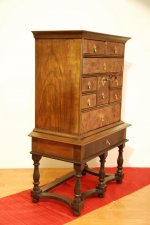FREDDY ROMAN
Well-known member
Hello All,
Over the years one thing seems to be common with all furniture makers, they love making furniture, but seem to hate finishing furniture. For me I enjoy both, I don't know why but I just do. For the last few years I have been working on trying to mimic that certain look that old furniture have. Why? Well I have been reproducing and repairing a lot of antique furniture. What I love about antique furniture is that dead flat, no luster look, with some alligatoring. Yes I know it takes practice, and yes I know people like to keep their secrets under their hat, but there are some who want to share. So if you like to share you methods please do so and thank you.
My technique that I have been playing with: Of late I been using shellac flat from Homesteadingfinishing.com, which works awesome. Then between coats I have been applying talc powder with a ponce pad, and then adding more finish by brush, pad or spray. Which in turn the item gets put in front of radiating heat to help create alligatoring, and layer separation. The method works pretty good, but it is still missing something. I also have on order some flat burnishing cream/wax and I will see what that gives me.
Some great examples of aged finish for some who don't know exactly what I'm talking about is the furniture from Anderson and Stauffer. Check out their site and then you will understand.
Well thank you for your time and can't wait and see what people do to mimic that look we all love.
Cheers,
Fred
Over the years one thing seems to be common with all furniture makers, they love making furniture, but seem to hate finishing furniture. For me I enjoy both, I don't know why but I just do. For the last few years I have been working on trying to mimic that certain look that old furniture have. Why? Well I have been reproducing and repairing a lot of antique furniture. What I love about antique furniture is that dead flat, no luster look, with some alligatoring. Yes I know it takes practice, and yes I know people like to keep their secrets under their hat, but there are some who want to share. So if you like to share you methods please do so and thank you.
My technique that I have been playing with: Of late I been using shellac flat from Homesteadingfinishing.com, which works awesome. Then between coats I have been applying talc powder with a ponce pad, and then adding more finish by brush, pad or spray. Which in turn the item gets put in front of radiating heat to help create alligatoring, and layer separation. The method works pretty good, but it is still missing something. I also have on order some flat burnishing cream/wax and I will see what that gives me.
Some great examples of aged finish for some who don't know exactly what I'm talking about is the furniture from Anderson and Stauffer. Check out their site and then you will understand.
Well thank you for your time and can't wait and see what people do to mimic that look we all love.
Cheers,
Fred

